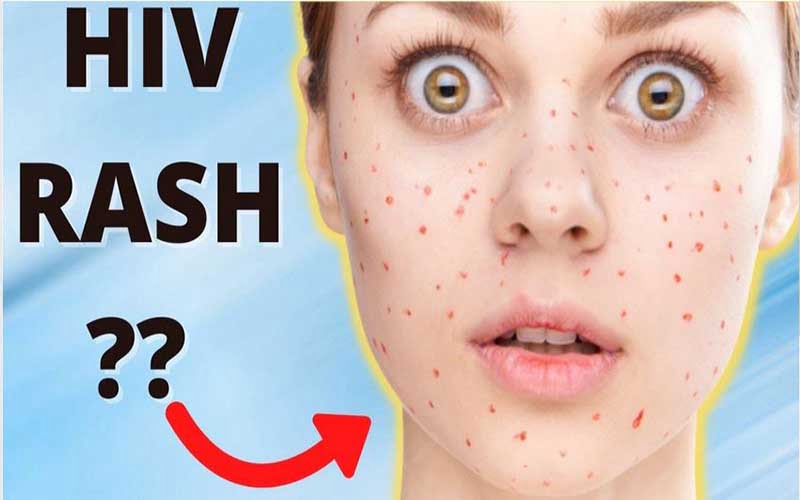
In this comprehensive article, we will discuss HIV rash, a common dermatological manifestation of HIV infection. HIV (Human Immunodeficiency Virus) is a viral infection that weakens the immune system, making the body more susceptible to various infections and conditions. One of the early signs of HIV infection is the development of a rash on the skin, commonly known as an HIV rash. This article will delve into the causes, symptoms, and treatment options, providing valuable insights into this aspect of HIV infection.
It refers to the appearance of a rash on the skin as a result of an HIV infection. It is a common dermatological manifestation of the virus and can provide valuable clues about an individual’s immune status. The rash may vary in appearance and severity, but it typically presents as reddish or pinkish lesions on the skin.
It occurs in a significant number of individuals with HIV. According to studies, approximately 80% of people with acute HIV infection experience some form of rash. However, it is important to note that not everyone infected with HIV will develop a rash.
No, it does not occur in all individuals with HIV. It is more commonly seen in individuals during the acute phase of HIV infection. The rash may also appear in later stages of HIV infection or as a side effect of antiretroviral therapy (ART).
Yes, it can be an early sign of HIV infection. In many cases, the appearance of a rash is one of the first indicators that prompt individuals to seek medical attention. However, it is important to remember that the presence of a rash does not confirm an HIV infection, and further testing is necessary for an accurate diagnosis.
During HIV infection, the virus replicates within the body and targets immune cells, particularly CD4+ T cells. As the immune system responds to the viral invasion, it triggers an inflammatory reaction that can manifest as a rash.
The inflammatory response to HIV infection can lead to the release of various cytokines and immune mediators, resulting in skin inflammation and the development of a rash. This response is an indication of the body’s attempt to combat the viral infection.
Antiretroviral therapy (ART) is the standard treatment for HIV infection. However, some individuals may develop a rash as a side effect of certain antiretroviral medications. It is crucial to differentiate between an HIV rash and a drug-related rash to provide appropriate medical management.
In individuals with weakened immune systems due to advanced immunodeficiency virus infection, opportunistic infections may occur. These infections can also cause rashes, which may be similar in appearance to an HIV rash. Proper evaluation and diagnosis by a healthcare professional are necessary to determine the underlying cause.
HIV rash typically appears as small, reddish or pinkish bumps on the skin. The rash can be flat or raised, and it may merge into larger patches. In some cases, the rash may be itchy or painful. The appearance and characteristics can vary among individuals.
HIV rash can occur on various parts of the body, but it often affects the trunk, including the chest, back, and abdomen. It can also appear on the face, arms, legs, and genital area. The distribution of the rash may differ from person to person.
Alongside the rashes, individuals may experience other symptoms associated with HIV infection. These may include fever, fatigue, sore throat, swollen lymph nodes, and muscle aches. It is important to note that the presence of these symptoms does not definitively indicate an HIV infection.
To diagnose an HIV rash, a healthcare professional will typically begin by taking a detailed medical history and performing a physical examination. The healthcare provider will inquire about symptoms, potential risk factors, and recent sexual encounters or drug use.
To confirm or rule out an immunodeficiency virus infection, laboratory tests are necessary. These tests may include an antibody test, an antigen test, or a combination test. Positive results will require further confirmatory testing.
In cases where the cause of the rash is uncertain, a dermatological evaluation may be recommended. A dermatologist can examine the rash closely, consider its characteristics, and conduct additional tests, such as a skin biopsy, if needed.
Treating HIV rash involves managing the underlying infection itself. This is achieved through antiretroviral therapy (ART), a combination of medications that suppress the replication of the virus and strengthen the immune system. Strict adherence to the prescribed ART regimen is crucial for optimal management.
In addition to treating the underlying HIV infection, symptomatic relief measures can be implemented to alleviate discomfort associated with the rash. These may include over-the-counter antihistamines for itching and the use of soothing topical creams or ointments.
If the rash is particularly bothersome, topical corticosteroids or antifungal creams may be prescribed by a healthcare professional. These medications can help reduce inflammation, itching, and any associated fungal infections that may occur alongside the rash.
In cases where the rash is a side effect of specific antiretroviral medications, a healthcare provider may recommend switching to alternative medications. It is crucial to consult with a healthcare professional before making any changes to the prescribed ART regimen.
Prevention is essential in reducing the risk of infection and the development of associated symptoms, including rashes. Practicing safe sex, using barrier methods like condoms, and avoiding sharing needles or other drug paraphernalia are crucial steps in preventing HIV transmission.
Engaging in safe sexual practices, such as regular condom use, can significantly reduce the risk of HIV transmission. It is important to have open and honest communication with sexual partners about this virus status and to get tested regularly.
Regular HIV testing is crucial for early detection and management of this infection. It allows individuals to access appropriate medical care, receive timely treatment, and reduce the risk of complications associated with it, including the development of rash.
A1: Yes, it can be itchy for some individuals. Itching is a common symptom associated with skin rashes. However, not all infections are itchy, and the severity of itching can vary among individuals.
A2: The duration can vary. In most cases, the rash lasts for a few weeks before resolving on its own. However, it is essential to consult with a healthcare professional for proper evaluation and guidance regarding the rash.
A3: Yes, it can sometimes be mistaken for other skin conditions, such as allergic reactions, eczema, or fungal infections. It is crucial to seek medical evaluation for an accurate diagnosis and appropriate management.
A4: No, it is not contagious. HIV is transmitted through specific body fluids, such as blood, semen, vaginal fluids, and breast milk, but not through skin-to-skin contact or casual contact with an individual.
A5: No, the risk of acquiring HIV from a person with an undetectable viral load is extremely low. When an individual consistently takes their prescribed antiretroviral medications and achieves an undetectable viral load, the risk of transmission is significantly reduced.
A6: Yes, in some cases, individuals may develop a rash after initiating antiretroviral therapy (ART). This can be a side effect of specific medications used in the ART regimen. It is important to consult with a healthcare professional if such a rash occurs for proper evaluation and management.
HIV rash is a common dermatological manifestation that can occur in individuals with immunodeficiency virus infection. While it can be an early sign of HIV infection, not all individuals with this infection will develop a rash. Proper diagnosis and management are crucial to address the underlying HIV infection and alleviate any associated symptoms. Regular HIV testing, practicing safe sex, and seeking medical care are important steps in preventing HIV transmission and related complications. If you suspect you may have an HIV rash or have concerns about HIV, it is essential to consult with a healthcare professional for accurate evaluation and guidance.
Recommended other topics:
Moral Support: Empowering You to Overcome Challenges
Alzheimer Nose Picking: Causes, Implications, and Management










© InfoDoot. All Rights Reserved.